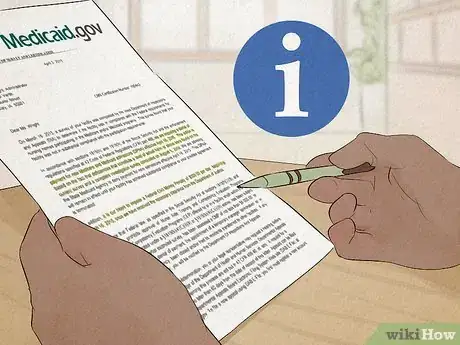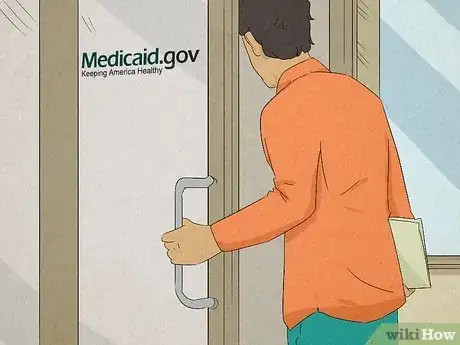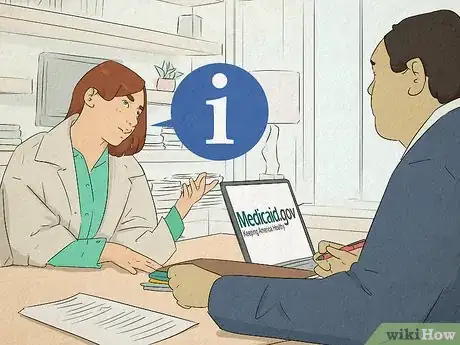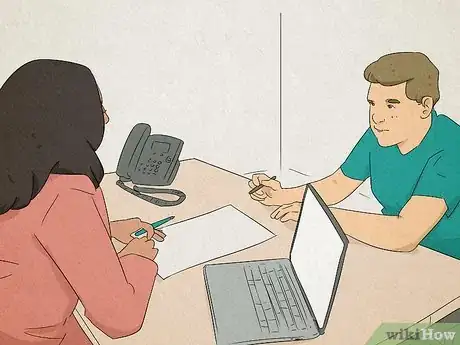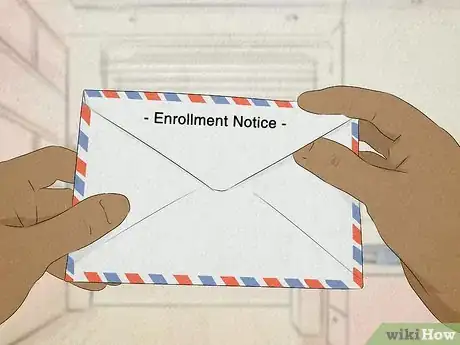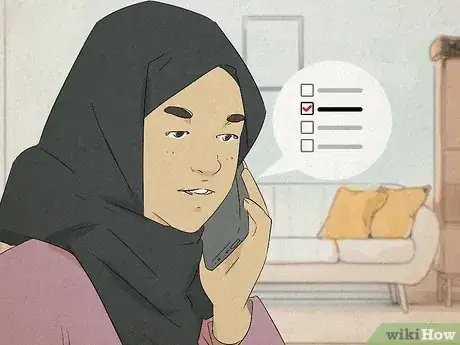This article was co-authored by wikiHow staff writer, Jennifer Mueller, JD. Jennifer Mueller is a wikiHow Content Creator. She specializes in reviewing, fact-checking, and evaluating wikiHow's content to ensure thoroughness and accuracy. Jennifer holds a JD from Indiana University Maurer School of Law in 2006.
There are 11 references cited in this article, which can be found at the bottom of the page.
This article has been viewed 54,745 times.
Learn more...
States offer several different managed care plans that you can choose from if you qualify for Medicaid. If you don't choose a plan, your state Medicaid office will choose one for you. If you want to switch to a different plan for any reason, the process depends on when you decide you want to make the change. You can change plans during the first 90 days for any reason. After that, you may only be able to switch providers for specific reasons, or you may have to wait for the open enrollment period.[1] Open enrollment typically occurs in November and December.[2]
Steps
Changing Plans in the First 90 Days
-
1Read the information provided by your state Medicaid office. When you enroll in Medicaid, you will receive an introductory packet from your state Medicaid office. These materials explain the different plans available for Medicaid recipients.[3]
- You may be able to choose a plan yourself, or the Medicaid office may choose a plan for you based on the information you provided to them when you signed up.
- If you don't like your initial plan for any reason, you are always free to change your plan any time within the first 90 days you are enrolled in Medicaid.
- If you didn't receive an introductory packet or confirmation letter in the mail, contact your local Medicaid office for assistance. Make sure they have your correct address and contact information.
-
2Choose the plan you want. All managed care plans offered by Medicaid provide the same basic services and benefits. However, some offer additional extra services that you may need. Additionally, not all doctors accept all health plans. If you want to keep your doctor, or if you're seeing particular specialists, make sure you're on a plan that they accept.[4]
- Comparison information is available from your state Medicaid office. Your introductory packet may include this information. It is also available on their website.
- Not all plans are available in all areas. There may be a map on the website of your state's Medicaid office that you can use to confirm the plan you want is available where you live.[5]
Advertisement -
3Log onto your online account, if possible. The easiest way to change your plan in the first 90 days is to do so online. All states offer online accounts for Medicaid recipients. You might also be able to change your plan through healthcare.gov, if you initially enrolled there.[6]
- If you have internet access but you haven't yet set up an online account, it's a good idea to do so. You will need your Medicaid ID number to set up an online account.
- In addition to changing your plan, you may also be able to change the doctor listed as your primary care provider (PCP) or update your contact information online.
-
4Call your state Medicaid office. If you're not comfortable on the internet or don't have consistent internet access, you can also change your plan by calling your state Medicaid office. Tell the operator that you want to change your Medicaid plan.[7]
- Have your information ready before you make the call. You'll need to be able to tell the operator your Medicaid ID number, the name of your current plan, and the name of the plan you want to switch to.
-
5Speak to a Medicaid counselor in person. Call your local Medicaid office and make an appointment. Let them know that you're within your first 90 days of Medicaid and want to change to a different plan.[8]
- If you have questions about the available plans, or aren't sure which one will work best for you and your family, a Medicaid counselor in your local office will be able to help you.
- For example, you might want to make sure you can still see the same doctors. The counselor would be able to help you identify plans that your doctors accept.
- If you or your children have a particular medical condition, such as diabetes or asthma, let the counselor know so they can identify the best plan for you that has programs to help manage those conditions.
Qualifying for a Special Enrollment Period
-
1Report major life changes as soon as possible. Major life changes could effect your eligibility for Medicaid. If you don't report them within 10 days, you could lose your Medicaid benefits. The reporting requirement applies regardless of whether the life change would entitle you to switch Medicaid providers.
- Changes that must be reported include a change of people in your household, change of address, change of employment or amount of income, and pregnancy.
- You may be able to report any changes online or over the phone. You can also go to your local Medicaid office and fill out a paper form describing the change.
- You may be asked to provide proof of the change you report. For example, if you've reported that you're pregnant, you may be asked to provide a statement from your doctor.
-
2Review the eligibility guidelines. After your first 90 days, you typically can't change Medicaid plans unless a significant life event has occurred, such as getting married or giving birth. You may also be able to switch plans if you move to another part of the state and your plan isn't available there.[9]
- Some states also allow you to switch plans after your first 90 days if your plan makes changes to services you need, or if you need specific medical care not offered by your plan.[10]
-
3Call or visit your state Medicaid office. If you believe you qualify for a special enrollment period and want to switch your plan, you can call and start the process over the phone or schedule an appointment to speak to a counselor in person.[11]
- You typically can't simply change your plan over the phone at this stage. You'll have to wait to get a transfer form in the mail, fill it out, and send it back. Make arrangements to go to the Medicaid office in person if you don't have time to wait.
- Make an appointment to speak with a counselor if you're not sure whether you qualify for a special enrollment period, or if you don't understand the eligibility guidelines.
- A special enrollment period typically only lasts 60 days from the date of the event of life change that triggered it. Don't delay if something happens that would enable you to switch plans, or you could lose your window of opportunity.[12]
-
4Provide information about your special circumstances. Gather any documentation you have that supports your need for a special enrollment period to switch Medicaid providers. Your state Medicaid office will evaluate this information and determine whether to allow you to switch plans.[13]
- If you're meeting with a Medicaid counselor in person, bring any documentation with you for them to review. They will decide whether you're eligible for a special enrollment period based on the information you provide.
- In some circumstances, you may receive a notice automatically that your special enrollment period has already started and you need to choose a new plan. For example, if you move to a different county in the same state and change your address with Medicaid, that might trigger a notice if your current plan isn't offered in your new county.
-
5Choose your new plan. You have 60 days from the date your special enrollment period starts to enroll in another plan. Your special enrollment period doesn't necessarily start on the day you notified Medicaid.[14]
- If you visit your local Medicaid office to talk to a counselor in person, you may be able to choose a different plan right then. The counselor will give you advice on which plan would best suit the needs of you and your family.
Using the Open Enrollment Period
-
1Receive notice of the start of open enrollment. After you've been enrolled in your plan for about a year, your state Medicaid office will send you a notification before the open enrollment period starts, typically in October or early November.[15]
- During the open enrollment period, you can switch Medicaid providers for any reason at all. If you didn't qualify for a special enrollment period, or you just don't like the plan you're on for whatever reason, this is your opportunity to switch.
-
2Compare the plans offered by your state. Your local Medicaid office will have information about the different plans available. You can also view this information online. Look for comparison charts that will help you easily determine what services and benefits are offered by which plans, and which plans are available in your area.[16]
- All plans typically provide the same basic services. However, some plans may offer special programs or added benefits that could be of interest to you. For example, some plans offer weight loss or smoking cessation programs.
-
3Make an appointment with a Medicaid counselor. Call your local Medicaid office if you want to speak to a counselor in person about your choices in Medicaid providers. The counselor will help you choose the best plan for you and your family based on the information you give them.[17]
- Medicaid counselors can also explain the different plans and benefits offered to you, and answer any questions you may have.
-
4Select the Medicaid provider you want. During open enrollment, you can switch Medicaid providers online, over the phone, or in person. Make note of the plan you want and have basic information, including your Medicaid ID number, handy.[18]
- If you switch providers online, you'll likely get a notification confirming that your request has been received. Keep this for your records in case there are any problems processing your request.
-
5Wait for confirmation of your new plan. Once you're enrolled in your new plan, the plan provider will send you a welcome packet with information on the benefits of the plan and how to use it. If you sign up during open enrollment, your new plan typically starts on January 1 of the following year.[19]
- Keep your welcome packet in a safe place. It contains important information about your plan and its benefits and services that you may need to access throughout the year. It also includes contact information if you have any questions or problems.
References
- ↑ https://www.myplan.healthy.la.gov/learn/changing-your-health-plan
- ↑ https://www.healthcare.gov/quick-guide/dates-and-deadlines/
- ↑ https://www.myplan.healthy.la.gov/learn/changing-your-health-plan
- ↑ https://www.georgia-families.com/GASelfService/pdfs/Eng/Statewidechart.pdf
- ↑ https://hhs.texas.gov/sites/default/files//documents/services/health/medicaid-chip/programs/managed-care-service-areas-map.pdf
- ↑ https://www.georgia-families.com/GASelfService/faces/jsp/login.xhtml?login_error=1
- ↑ https://www.georgia-families.com/GASelfService/en_US/home.htm
- ↑ https://www.georgia-families.com/GASelfService/en_US/home.htm
- ↑ https://www.healthcare.gov/coverage-outside-open-enrollment/special-enrollment-period/
- ↑ https://www.myplan.healthy.la.gov/learn/changing-your-health-plan
- ↑ https://www.myplan.healthy.la.gov/learn/changing-your-health-plan
- ↑ https://dchealthlink.com/help/articles/en_US/FAQ/special-enrollment-circumstance-change-plan-outside-open-period-qualifying-life-events
- ↑ https://dchealthlink.com/help/articles/en_US/FAQ/special-enrollment-circumstance-change-plan-outside-open-period-qualifying-life-events
- ↑ https://dchealthlink.com/help/articles/en_US/FAQ/special-enrollment-circumstance-change-plan-outside-open-period-qualifying-life-events
- ↑ https://www.georgia-families.com/GASelfService/en_US/choosing.htm#changing
- ↑ https://www.georgia-families.com/GASelfService/pdfs/Eng/Statewidechart.pdf
- ↑ https://www.georgia-families.com/GASelfService/en_US/news.htm#How
- ↑ https://www.georgia-families.com/GASelfService/pdfs/Eng/Statewidechart.pdf
- ↑ https://www.georgia-families.com/GASelfService/en_US/news.htm#How
- ↑ https://www.hca.wa.gov/free-or-low-cost-health-care/apple-health-medicaid-coverage/change-my-health-plan
About This Article
If your Medicaid provider doesn’t offer the best service for you, you can switch to a new provider under certain circumstances. If you’ve just signed up, you can change your provider for the first 90 days for any reason. You can also switch after 90 days if you meet special criteria, like getting married or giving birth. Some states will also allow you to change if your plan makes changes to the services you need or if you need specific medical care not offered by your plan. Otherwise, you’ll have to wait until the enrollment period, which is usually in October or early November. All you need to do is log into your Medicaid account online, call the Medicaid office and quote your ID number, or go into your local office in person. For more tips, including how to research other Medicaid plans, read on!
